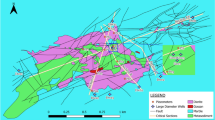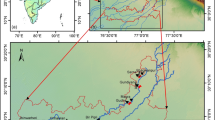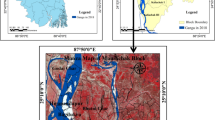Abstract
The bank sediments along the extremely meandered Dhansiri River channel, a south bank tributary of the mighty Brahmaputra River, with erosion potentiality have been investigated to evaluate its certain geotechnical characteristics. The study has shown that the bank sediments are basically composed of CL and ML types of soil. These types of sediments are very much prone to liquefaction which in turn related to erosion susceptibility. The bank stability analysis has differentiated the studied stretch into unstable, at risk and stable zones. Most of the erosion affected zones along the channel reach under study are located within the unstable or at risk zones. The field study around Butalikhowa, Barguriagaon, Golaghat and Duchmuagaon areas along the channel with active erosion activity has supported our contention and practical utility of the present study. It is expected that such type of study will help in providing certain inevitable baseline information for various channel management practices for this extremely flood prone areas of Northeast India.
Similar content being viewed by others
References
Darby, S.E. and Simon, A. (1999) Incised River Channel. John Wiley and Sons, Chichester, United Kingdom, 442p.
Dutta, M.K. (2007) Dhansiri River Channel, Assam — A geomorphologic attribute, Unpubld. Ph.D. Thesis, Dibrugarh University, Assam.
EPA (Environmental Protection Agency) (2003) River Morphology, Low land River bank stability and erosion assessment, pp.6-46–6-52.
IS-1498 (1970) Classification and Identification of soils for general Engineering purposes. Bureau of Indian Standard (BIS), New Delhi.
IS-2720 Part V. (1965) Determination of liquid and plastic limits, Indian Standard Institution, New Delhi.
Rinaldi, M. and Casagli, N. (1999) Stability of stream banks formed in partially saturated soils and effects of negative pore water pressure: the Sieve River (Italy), Geomorphology, v.26, pp.253–277.
Simon, A., Curini, A., Darby, S.E. and Lagendoen, E.J. (2000) Bank and near bank processes in an incised channel. Geomorphology, v.35, pp.193–218.
Singh, A. and Chowdhary, G.R. (1994) Soil Engineering in Theory and Practice: Fundamentals and General Principles. CBS Publishers & Distributors, New Delhi, 969p.
Tokaldany, A, E. (2003) Bank Stability analysis for predicting reach scale land loss and sediment yield. Jour. Amer. Wat. Res. Assoc., pp.1–11.
Thorne, C.R. and Abt, S.R. (1993) Analysis of riverbank instability due to toe scour and lateral erosion. Earth Surface Processes and Landforms, v.18, pp.835–843.
Unified Soil Classification System for Roads, Airfields, Embankments and Foundations, Military Standard. (1962) MIL-STD-619 A, U.S. Dept. of Defence, Washington.
Author information
Authors and Affiliations
Corresponding author
Rights and permissions
About this article
Cite this article
Kotoky, P., Dutta, M.K., Goswami, R. et al. Geotechnical properties of the bank sediments along the Dhansiri River channel, Assam. J Geol Soc India 78, 175–183 (2011). https://doi.org/10.1007/s12594-011-0070-z
Received:
Accepted:
Published:
Issue Date:
DOI: https://doi.org/10.1007/s12594-011-0070-z




